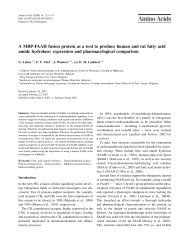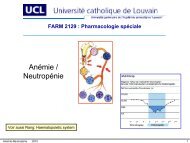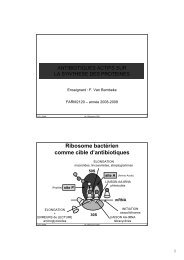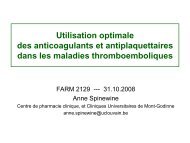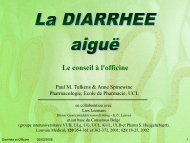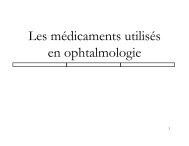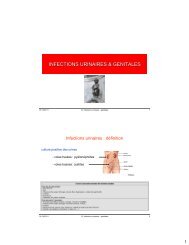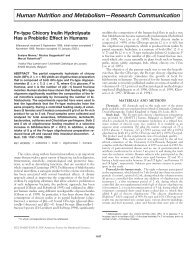Infections gastro-intestinales
Infections gastro-intestinales
Infections gastro-intestinales
Create successful ePaper yourself
Turn your PDF publications into a flip-book with our unique Google optimized e-Paper software.
<strong>Infections</strong> <strong>gastro</strong>-<strong>intestinales</strong><br />
1. Gastrite à Helicobacter pylori<br />
physiopathologie<br />
Hypersécrétion<br />
acide<br />
(Zollinger-Elison)<br />
Sécrétion<br />
d’acide et de pepsine<br />
Helicobacter<br />
pylori<br />
AINS stress<br />
Défense de<br />
la muqueuse<br />
altérée<br />
Muqueuse endommagée<br />
ULCERE
<strong>Infections</strong> <strong>gastro</strong>-<strong>intestinales</strong><br />
1. Gastrite à Helicobacter pylori<br />
Endoscopic pictures of the stomach and duodenum.<br />
(a) Erythema of the gastric antrum. This appearance correlates poorly with histologic<br />
gastritis and may be a normal finding.<br />
(b) Duodenal ulceration.<br />
(c) Gastric ulcer. Note the clot in the base indicating recent bleeding and high risk of rebleed<br />
and the endoscope entering the stomach through the cardia.<br />
Infectious Diseases - D. Armstrong & J. Cohen, Eds. 1999.
<strong>Infections</strong> <strong>gastro</strong>-<strong>intestinales</strong><br />
1. Gastrite à Helicobacter pylori<br />
causes de l’ulcère duodénal gastrique:<br />
infection à H. p. 90% 60-70%<br />
médicaments (AINS) 5-10% 25-30 %<br />
traitement<br />
• 1 anti-acide (anti-H 2 ou inhibiteur de la pompe à protons)<br />
• 2 antibiotiques: macrolide (clarithromycine)<br />
métronidazole ou amoxycilline ou tétracycline
<strong>Infections</strong> <strong>gastro</strong>-<strong>intestinales</strong>
2. Gastro-entérites<br />
facteurs favorisants<br />
• hygiène personnelle<br />
<strong>Infections</strong> <strong>gastro</strong>-<strong>intestinales</strong><br />
• baisse de l’acidité gastrique (barrière aux infections)<br />
• mobilité intestinale (module la résorption d’eau et de sels)<br />
• nature de la flore commensale<br />
risque majeur = déshydratation, surtout chez le bébé<br />
chez la personne âgée
2. Gastro-entérites<br />
diarrhées inflammatoires:<br />
<strong>Infections</strong> <strong>gastro</strong>-<strong>intestinales</strong><br />
- selles glairo-sanguinolantes<br />
- agent invasif (localisation intracellulaire) ou cytotoxique<br />
(entraînant des modifications du cytosquelette et la production de cytokines)<br />
agents invasifs:<br />
Salmonella, Shigella, Yersinia, Campylobacter<br />
cytomégalovirus<br />
Entamoeba histolytica<br />
agents cytotoxiques:<br />
E. coli, Clostridium
2. Gastro-entérites<br />
diarrhées hydriques<br />
<strong>Infections</strong> <strong>gastro</strong>-<strong>intestinales</strong><br />
- selles liquides et abondantes<br />
- bactéries produisant des endotoxines<br />
(activation de l’adénylate cyclase, activation d’enzymes, activité secrétoire),<br />
- virus, parasites<br />
Vibrio cholera, E. coli, Clostridum perfringens, S. aureus, B. cereus<br />
Rotavirus, adenovirus<br />
Giardia Lamblia, Cryptosporidium
2. Gastro-entérites<br />
<strong>Infections</strong> <strong>gastro</strong>-<strong>intestinales</strong><br />
colite pseudo-membraneuse à Clostridium difficile<br />
bactérie anaérobie, colonisant les patients ayant reçu un antibiotique à large<br />
spectre<br />
production de toxines désorganisant l’actine<br />
endommangeant les neurones<br />
Principles and practice of infectious diseases - Mandell - 2000
2. Gastro-entérites<br />
<strong>Infections</strong> <strong>gastro</strong>-<strong>intestinales</strong><br />
agents responsables traitement de choix alternative<br />
Clostridium difficile métronidazole vancomycine<br />
réhydratation<br />
antibiotique si invasion<br />
souche toxigène<br />
E. coli cotrimoxazole / FQ<br />
Salmonella FQ cephalo,<br />
cotrimoxazole<br />
Shigella FQ céphalo, ampi,<br />
cotrimoxazole<br />
Campylobacter FQ ML, doxy<br />
Yersinia FQ cotrimoxazole, AG<br />
Vibrio cholerae FQ cotrimoxazole<br />
doxy<br />
Rotavirus/adenovirus réhydratation
2. Gastro-entérites<br />
<strong>Infections</strong> <strong>gastro</strong>-<strong>intestinales</strong><br />
intoxications alimentaires: bactéries productrices de toxines<br />
S. aureus salades, patisserie, volaille<br />
B. cereus viandes, légumes<br />
Clostridium perfrigens viande, volaille<br />
Vibrio parahemolyticus coquillages<br />
Salmonella produits laitiers, viande, oeufs, eau<br />
Shigella salades, eau<br />
E. coli eau<br />
Campylobacter volaille, eau, produits laitiers<br />
Vibrio cholerae eau<br />
Yersinia produits laitiers<br />
Clostridium botulinum conserves, viandes<br />
Listeria produits laitiers, charcuteries
<strong>Infections</strong> <strong>gastro</strong>-<strong>intestinales</strong><br />
demandez conseil à votre pharmacien ….<br />
• donner les conseils d’hygiène (contamination et transmission)<br />
• donner des conseils diététiques (aliments à conseiller et à éviter)<br />
• insister sur l’importance de l’hydratation (diarrhée)<br />
• vérifier l’adéquation du choix thérapeutique pour le patient considéré<br />
• recherche de facteurs de risque (médicaments !)



